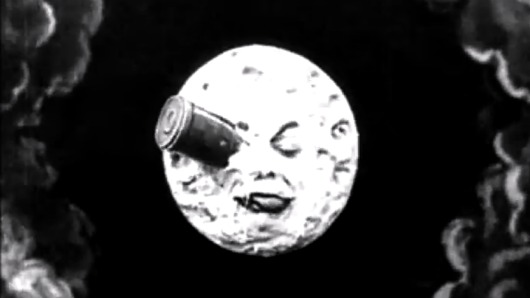
The first time I crossed paths with French filmmaker Georges Méliès was at the age of eleven, while watching a music video by the Smashing Pumpkins. It was for the song ‘Tonight Tonight,’ where a couple travels to the Moon, gets attacked and kidnapped by a group of aliens, escapes via rocket ship and then crashes into the sea. At the end, a boat sails by with the words S.S. Méliès on the side.
I had no idea who Méliès was at the time, nor that his short film — ‘Le Voyage Dans La Lune’ (a.k.a. ‘A Trip to the Moon’) — inspired the Pumpkins’s video. In fact, I wouldn’t find this out until 15 years later, when I saw Martin Scorsese’s, ‘Hugo.’ The director’s new film, in theaters now, features a young orphan who discovers the work of Georges Méliès (played by Ben Kingsley) through a mysterious automaton left behind by his deceased father. Throughout the movie, Scorsese recreates several of Méliès’ shorts, including the iconic ‘Le Voyage.’
Although his last project was made more than a century ago, George Méliès is still considered one of the pioneers of cinema, credited for his innovations in special effects and film technique. And when artists as varied as Scorsese and the Smashing Pumpkins have been inspired by his work, you know it has to be someone worth checking out. (The fact that ‘Hugo’ just won Best Picture at the National Board of Review only adds to this intrigue.) So, who is Georges Méliès, and why is he considered one of the godfathers of filmmaking?
Born in Paris in 1861, Méliès was the son of a couple who ran a successful footwear business. In 1884, he traveled to London, where Méliès became fascinated with magic, after seeing a show by the magicians Maskelyne and Cooke. When he returned to France, Georges began performing his own illusions. However, his film breakthrough came while attending the premiere of a Lumières brothers show. The Lumières were credited with using one of the first film cameras, a cinematographe; after the premiere, Méliès tried, but failed, to buy one from the brothers. Not one to give up easily, he went with the next best option, and built a camera on his own.
Méliès soon began making short films, which were some of the first to use substitution (an effect where a person or object appears then disappears or changes into something else in the blink of an eye). Méliès eventually bought his own studio in Montreuil, which served as his workshop for almost three decades. He directed, produced, wrote, designed and sometimes starred in his films, which became popular, especially overseas. Méliès would go on to make over 500 movies in his career, two of which are considered some of the first of their genre (‘Le Voyage’ for science fiction and ‘The Haunted Castle’ for horror).
However, by 1909, the novelty of his work began to wear off. Méliès would eventually go bankrupt and be forced to sell his studio. Many of his films were destroyed and used to make shoe heels (this is why countless Méliès’ works no longer exist today). The world soon forgot about Georges Méliès, as he went to work in a toy store in Gare Montparnasse train station in Paris (which is where the bulk of Scorsese’s ‘Hugo’ takes place). But in the 1920s, things began to change. French surrealists rediscovered the director’s old work, and Méliès was eventually awarded the Legion of Honor. Seven years later, he passed away. The last movie he made was ‘The Knight of the Snows,’ in 1916.
Scorsese does a beautiful job recreating the films of Méliès, with unique characters and layered set designs bursting with color. Of course, these details were never crystal clear on the originals, but you can still feel Méliès’ energy and creative passion behind each of them. He enjoyed dazzling audiences of all ages, just like he had done when he was a magician. It’s easy to understand why, at the turn of the twentieth century, moviegoers were captivated by them.
http://www.youtube.com/80ywEc7juXw
It is interesting to go back and look through some of Méliès films and compare them to what Scorsese did in ‘Hugo.’ Some of Georges old movies are even available online: a quick YouTube search will yield not only ‘Le Voyage,’ but ‘Un homme de têtes’ (‘The Four Troublesome Heads’) where Méliès pulls his head off his shoulders and sets it on the table, ‘The Haunted Castles,’ which features a demon who summons skeletons and ghosts, and ‘Conquête du Pôle’ (‘Conquest of the Pole’) where balloonists travel to the North Pole, only to be chased by a man-eating frost giant.
It’s possible that today’s audiences, particularly children, will likely find these original shorts a bit boring and cheesy. Many are devoid of color, lack the typical narrative structure we see in modern films and do not feature the CG we’ve come to expect from today’s blockbusters. However, this makes Scorsese’s ‘Hugo’ all the more poignant. Here is one of the finest directors of all time, looking to introduce the wonder of Méliès to a whole new generation (and, yes, that includes adults). Before I saw ‘Hugo,’ I just didn’t care about Georges Méliès; now I do, and I understand his contribution to film. It had been years since I had seen the Pumpkins ‘Tonight Tonight’ video, so when I finally discovered the Méliès’ connection, I watched it again, with a mix of nostalgia, enthusiasm and fascination — a reaction Scorsese, Méliès and every other filmmaker has been looking to create for more than 100 years.
[Sources: ‘The Hugo Movie Companion: A Behind the Scenes Look at How a Beloved Book Became a Major Motion Picture’; George Méliès Official Website]
[Photo: YouTube]



